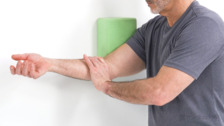Advanced Telehealth Techniques: Evaluation and Intervention
Techniques of the Upper Extremity
Presented by Anna DeLaRosby, Julie Mulcahy, and Todd Norwood
12-Month Subscription
Unlimited access to:
- Thousands of CE Courses
- Patient Education
- Home Exercise Program
- And more
Telehealth continues to expand the capabilities of physical therapy, allowing clinicians to assess and treat upper extremity conditions remotely. This course provides an in-depth guide to conducting comprehensive telehealth evaluations and interventions for the shoulder, elbow, wrist, and hand. Participants will learn how to effectively communicate examination procedures, conduct medical screenings, and assess range of motion, strength, and neurological function via telehealth. The course also covers special tests and self-mobilization techniques tailored for remote settings, equipping providers with strategies to ensure high-quality patient care. By the end of this course, physical therapists will have the skills needed to confidently deliver upper extremity rehabilitation through telehealth while maintaining accuracy, patient safety, and treatment efficacy.
Learning Objectives
- Communicate instructions regarding camera view and patient procedure to patients while conducting a telehealth upper extremity examination
- Complete medical screening and triage for the upper extremity
- Demonstrate a thorough remote evaluation of upper extremity range of motion
- Direct the patient through special tests for the upper extremity evaluation
- Develop personalized telehealth interventions for the upper extremity
- Instruct the patient in self-joint and/or soft-tissue mobilization techniques of the upper extremity that are suitable for remote delivery
Meet your instructors

Anna DeLaRosby
Anna has been a physical therapist since receiving her doctorate in physical therapy in 2008 and loves all things PT. Anna became certified in mechanical diagnosis and therapy in 2012, and in 2014, she became a board-certified orthopedic clinical specialist. Anna is the clinical program manager for Physera Physical Therapy…

Julie Mulcahy
Julie Mulcahy received her doctorate in physical therapy from the University of Michigan. For the past 20+ years, she has specialized in orthopedics, sports medicine, and women’s health. She obtained her Certificate of Achievement in Pregnancy and Postpartum Physical Therapy (CAPP-OB) in 2021 and her LAMP Institute for…

Todd Norwood
Todd received his doctorate in physical therapy from the University of Southern California and his BA in human biology from Stanford University. He is a board-certified clinical specialist in both orthopedic physical therapy and sports physical therapy and is a fellow of the American College of Healthcare Executives. Todd is…
Chapters & learning objectives

1. Subjective and Objective Assessment
This chapter focuses on the foundational aspects of remote upper extremity assessment. Participants will learn how to set up an effective telehealth evaluation environment, ensuring proper patient positioning and camera angles for optimal assessment. The chapter covers subjective history-taking, red flag screening, and symptom behavior analysis to help clinicians identify potential serious conditions. Objective assessments include posture analysis, sensation testing, and range-of-motion evaluations for the shoulder, elbow, wrist, and hand. Clinicians will gain insight into how to guide patients through self-directed assessments to maximize diagnostic accuracy in a virtual setting.

2. Objective and Special Tests for the Upper Extremity
This chapter explores strength testing, neurological assessments, and special tests adapted for telehealth. Participants will learn how to direct patients in self-testing using functional alternatives and common household items for resistance. The chapter covers standardized myotome testing, grip strength evaluations, and special tests for conditions such as rotator cuff pathology, carpal tunnel syndrome, and elbow instability. Emphasis is placed on clear communication, demonstration techniques, and strategies to ensure feasibility, reliability, and validity in remote assessments.

3. Interventions for the Upper Extremity
In this chapter, participants will learn to develop personalized telehealth interventions for upper extremity conditions, focusing on self-mobilization and strengthening exercises. The chapter covers techniques for the shoulder, elbow, wrist, and hand, integrating patient education and progressive mobility strategies. Clinicians will explore how to instruct patients in self-mobilization using external tools and adaptive positioning to facilitate pain relief and functional improvement. By the end of the chapter, participants will have a tool kit of remote interventions to optimize rehabilitation outcomes.
More courses in this series

Advanced Telehealth Techniques: Translating Clinical Skills to Telehealth
Anna DeLaRosby, Julie Mulcahy, and Todd Norwood

Advanced Telehealth Techniques: Evaluation and Intervention Techniques of the Spine
Anna DeLaRosby, Julie Mulcahy, and Todd Norwood

Advanced Telehealth Techniques: Evaluation and Intervention Techniques of the Upper Extremity
Anna DeLaRosby, Julie Mulcahy, and Todd Norwood

Advanced Telehealth Techniques: Evaluation and Intervention Techniques of the Lower Extremity
Anna DeLaRosby, Julie Mulcahy, and Todd Norwood